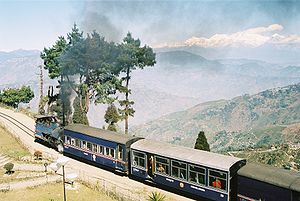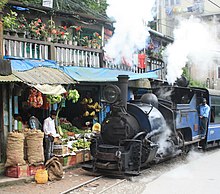Darjeeling Himalayan Railway
| Darjeeling Himalayan Railway | |
|---|---|
 |
|
| A Darjeeling Himalayan Railway train on Batasia Loop | |
| Locale | West Bengal, India |
| Terminus | Darjeeling |
| Commercial operations | |
| Name | Darjeeling Himalayan Railway (DHR) |
| Original gauge | 2 ft (610 mm) |
| Preserved operations | |
| Operated by | Indian Railways, supported by Darjeeling Himalayan Railway Society |
| Stations | 13 (New Jalpaiguri, Siliguri Town, Siliguri Junction, Sukna, Rongtong, Tindharia, Gayabari, Mahanadi, Kurseong, Tung, Sonada, Ghum and Darjeeling) |
| Length | 78 km (48 mi) between Siliguri and Darjeeling |
| Preserved gauge | 2 ft (610 mm) |
| Preservation history | |
| Mountain Railways of India | |
|---|---|
| Name as inscribed on the World Heritage List | |

Typical roadside scenery. The train is rolling through a fruit shop.
|
|
| Location | India |
| Type | Cultural |
| Criteria | ii, iv |
| Reference | 944 |
| UNESCO region | Asia-Pacific |
| Inscription history | |
| Inscription | 1999 (23rd Session) |
| Extensions | 2005; 2008 |
The Darjeeling Himalayan Railway, also known as the "Toy Train", is a 2 ft (610 mm) narrow-gauge railway that runs between New Jalpaiguri and Darjeeling in the Indian state of West Bengal, India. Built between 1879 and 1881, the railway is about 78 km (48 mi) long. Its elevation level varies from about 100 m (328 ft) at New Jalpaiguri to about 2,200 m (7,218 ft) at Darjeeling. Four modern diesel locomotives handle most of the scheduled services; however the daily Kurseong–Darjeeling return service and the daily tourist trains from Darjeeling to Ghum (India's highest railway station) are handled by the vintage British-built B Class steam locomotives.
The railway, along with the Nilgiri Mountain Railway and the Kalka–Shimla Railway, is listed as the Mountain Railways of India UNESCO World Heritage Site. The headquarters of the railway is in the town of Kurseong. Operations between Siliguri and Kurseong were temporarily suspended in 2010 following a Landslide at Pagla Jhora and another near Tindharia in 2011. However the normal Toy Train service resumed between New Jalpaiguri (NJP) and Darjeeling from 2 December 2015.
A broad gauge railway connected Calcutta (now Kolkata) and Siliguri in 1878. Siliguri, at the base of the Himalayas, was connected to Darjeeling by a cart road (the present day Hill Cart Road) on which "Tonga services" (carriage services) were available.
Franklin Prestage, an agent of Eastern Bengal Railway Company, approached the government with a proposal of laying a steam tramway from Siliguri to Darjeeling. The proposal was accepted in 1879 following the positive report of a committee formed by Sir Ashley Eden, the Lieutenant Governor of Bengal. Construction started the same year.
...
Wikipedia
